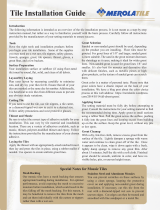Tile Installation Guide
Introduction
The following information is intended as an overview of the tile installation process. It is not means as a
step-by-step instructional manual, but rather to familiarize yourself with the basic process. Carefully
follow all instructions provided by the manufacturers of your setting materials to ensure success.
Tools
Have the right tools and installation products before you begin your tile installation. Some of the supplies
you may need are a wet saw, tile nippers, safety glasses, trowels, sponges, grout, tile spacers, thinset,
gloves, a grout float, and a few buckets.
Surface Preparation
Your installation surface or subfloor (if using floor-rated tile) must be sound, flat, solid, and clean of all
debris.
Layout/ Dry Laying
Plan your layout by measuring carefully to minimize cuts, and dry lay your tiles for fit. Ensure that all of
your tiles are marked as the same dye lot number. Additionally, is it beneficial to mix tiles from different
cases to prevent any obvious shade variations.
Cutting Tile
If you need to cut the tile, use tile nippers, a tile cutter, or a diamond- tipped wet saw to cut it to a desire
size. Follow safety precautions and wear protective glasses.
Thinset and Mastic
Be sure to select the correct type of adhesive suitable for your installation. This can vary by tile material
and installation location. There are a variety of adhesives available, such as a mastic, thinset, polymer-
modified thinset and epoxy. Follow the instructions provided by the manufacturer of your chosen
adhesive.
Laying the Tiles
Apply the thinset with an appropriately- size notched trowel, then lay and press the tiles in place, using a
rubber mallet if needed. Use spacers to create uniform grout lines.
Grout Selection
Sanded or non-sanded grout should be used, depending on the product you are installing. Floor tiles must
be grouted. For grout lines of 1/8” and larger, sanded grout is more suitable. The sand in the grout mixture
decreases the shrinkage as it cures, making it ideal for wider grout lines. Non-sanded grout is used for
grout lines 1/8” and smaller. It’s also best for mosaics and decorative tiles with delicate finishes, such as
metallic pieces or high gloss products, as the texture of sanded grout can scratch them.
Grout color is a matter of personal taste. Please note that grout colors have a drastic impact on the look of
your installation.







